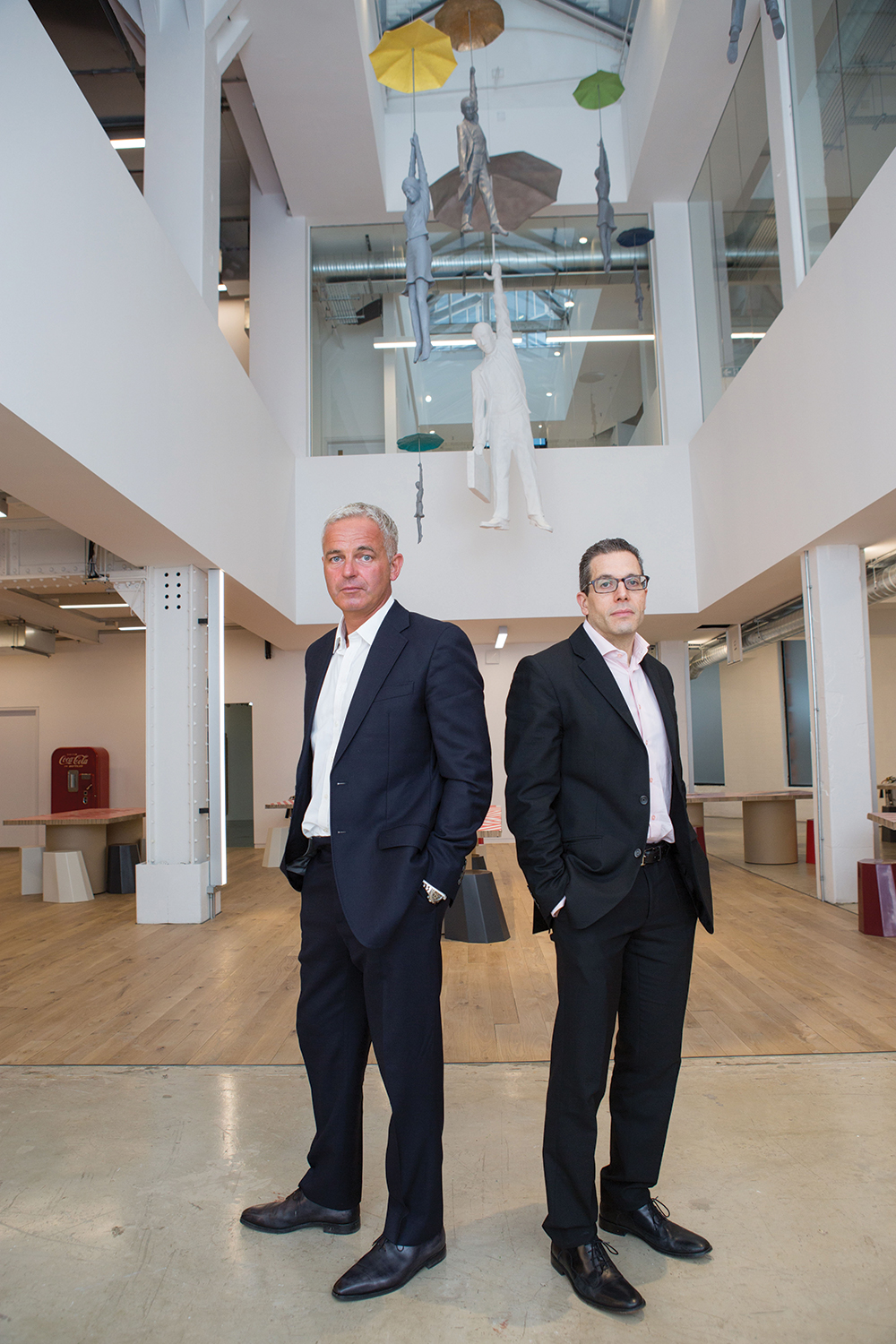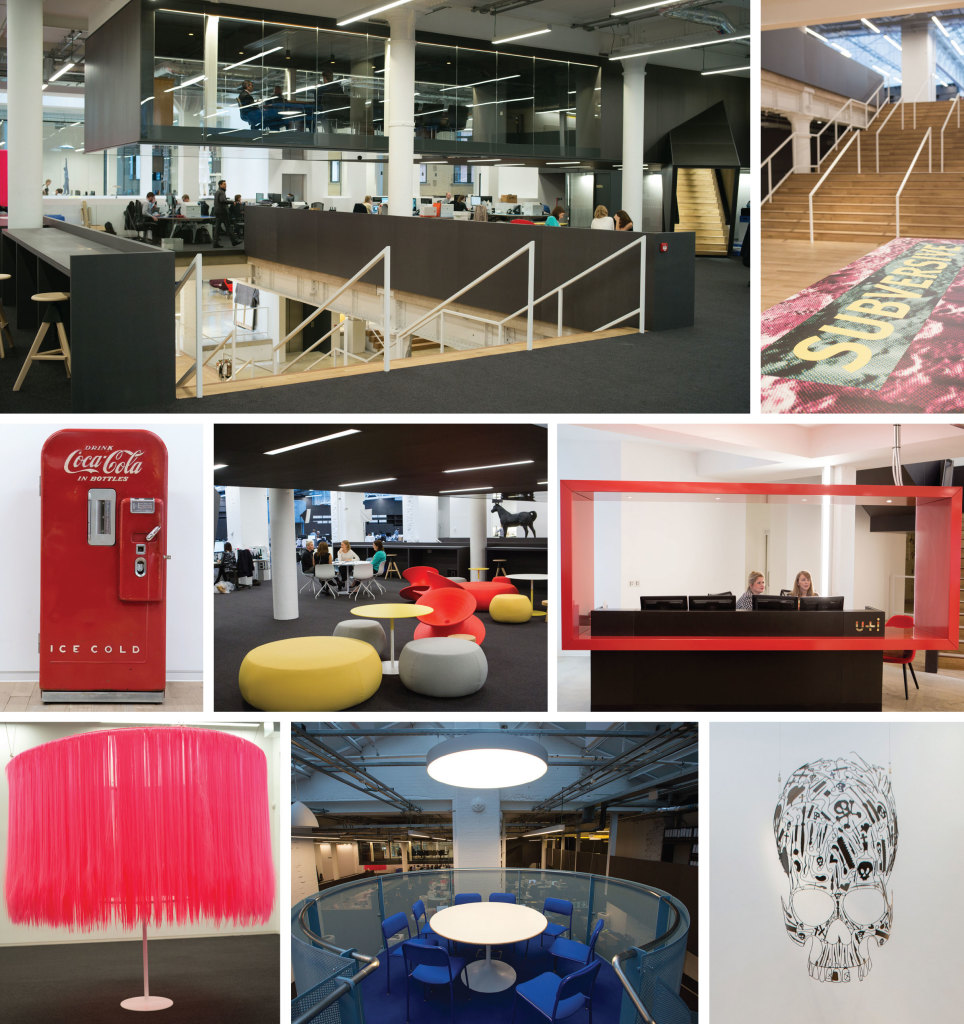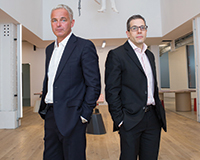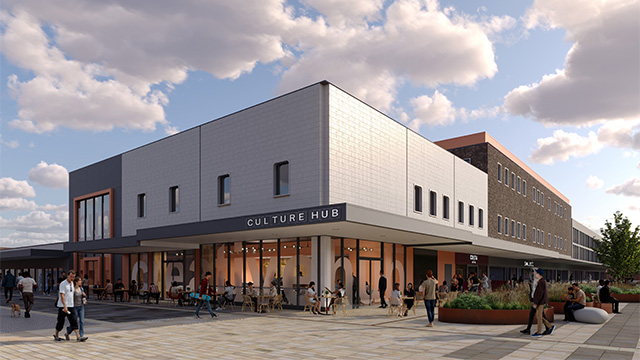Complex Development Securities has transformed itself into U+I, a propco with a clear focus on regeneration and wielding a socio-economic conscience. Will its new strategy deliver for its shareholders? Jack Sidders talks to the firm’s executives, Matthew Weiner and Richard Upton. Photographs by Matt Writtle
 Universal + Imaginative, proclaims the advertising campaign promoting Development Securities’ new brand. Unafraid + Inspired. The bold messaging takes up the company’s malleable new name, U+I Group, and plays with it in aspirational fashion.
Universal + Imaginative, proclaims the advertising campaign promoting Development Securities’ new brand. Unafraid + Inspired. The bold messaging takes up the company’s malleable new name, U+I Group, and plays with it in aspirational fashion.
Of course, the same letter combination works for those that would mock. “‘Useless and incompetent’ was one suggestion,” says new chief executive Matthew Weiner, who took over the running of the company from long-serving boss Michael Marx in the summer of 2015.
In fact, the name is inspired by the motto of a group of dock workers that once drank in a Greenwich pub on a site now owned by the company. The attention to etymology is important to Richard Upton, the company’s deputy chief executive, who joined via its 2014 acquisition of Cathedral Group. He says it shows how this company is unafraid of being different from its peers and how the thinking behind the new brand runs right through its new strategy.
And if the rebrand seemed bold – particularly to traditional property types who would mock – the company’s new Victoria, SW1, headquarters will probably have them choking on their cigars (see box, overleaf).
As it promised last year, the company has built a headquarters that, in its words, is “nothing short of extraordinary”. It features everything from the weird – a portable pink, fluffy meeting room – to the wonderful, such as plaster-cast figures floating under umbrellas from the ceiling like an army of invading Edwardian housekeepers.
Sitting in the glass-encased boardroom suspended over an auction room turned office, Weiner and Upton give their first in-depth interview since taking over the reins of the company and explain why the rebrand goes a lot further than U+I.
Paring down the message
The briefing note sent out when the rebrand was announced reads more like a manifesto than a corporate mission statement. DevSec was sometimes criticised for its complexity – at one point it had 85 schemes in its development and trading portfolio despite a relatively modest £275m market capitalisation. The fact that it made forays into a whole range of different sectors, from care homes to hotels, as it became largely priced out of central London office development, only served to complicate the message to shareholders further.
“One of our tasks was to reduce complexity. A project that’s going to make a £2m profit often takes the same energy as a project that’s going to make £5m. We decided to use our time more efficiently because we are all in a race against the market cycle,” says Weiner.
The new mission is spelled out clearly. U+I focuses on regeneration, community creation and land acquisition. Within each there is a commitment to development with a socio-economic conscience.
“U+I is a company that believes it has a duty to face up to the nation’s challenges,” reads the briefing note. In most other corporate reports it would be easy to dismiss this as yet more greenwash and guff, but listening to Weiner and Upton there’s a strong sense that they mean it. The obvious question is how can they achieve these lofty ambitions at the same time as keeping shareholders happy? “The two go hand in hand. It is as simple as that,” says Weiner. “There’s a misconception that to achieve social change you sacrifice profit. We don’t believe that at all. We believe that the combination of the two create shareholder value.”
Underpinning this belief is a willingness to take a longer-term approach to development than the standard build-and-sell model. The theory goes that in order to create interesting places that communities will embrace, developers should forget about focusing on corporate covenants and long-term leases.
By leasing space to local start-ups on short-term leases U+I hopes to give communities a greater sense of place, which will enhance values in the long term. Weiner and Upton call it “greenhousing”, nurturing smaller local businesses that give U+I’s developments a unique sense of place.
“The lease length covenant argument is dead,” says Weiner.
“Lease lengths are getting shorter, anyway. If you create a great place, people will come.”
Public bodies as partners
The idea builds on Cathedral’s strong track record of working in partnership with public bodies, often to help redevelop town centres. In Deptford, SE8, it painstakingly brought railway arches back to life and has leased them to start-ups that have helped re-inject life into a town centre in which few propcos would have deigned to consider investing.
The idea now as U+I is that the company can afford to remain involved with such projects for the longer term and participate in the enhanced capital growth that reinvigorating such overlooked areas can bring.
“Once you create a shiny thing in murky parts, you’ve got something that exhibits significantly better performance,” says Upton.
Rethinking land acquisition
 That longer-term approach is also in evidence in the company’s land acquisition strategy. DevSec has long had an investment portfolio that Weiner says was largely isolated from the development and trading assets and just relied on for its income. Since merging with Cathedral Group, he has led a wholesale review of the portfolio and decided to introduce a strategy that makes it work for the benefit of the development and trading side of the business too.
That longer-term approach is also in evidence in the company’s land acquisition strategy. DevSec has long had an investment portfolio that Weiner says was largely isolated from the development and trading assets and just relied on for its income. Since merging with Cathedral Group, he has led a wholesale review of the portfolio and decided to introduce a strategy that makes it work for the benefit of the development and trading side of the business too.
By selling £40m of investment assets – around one-fifth of the portfolio – it can afford to start investing in long-term development opportunities that are “warehoused” in the investment portfolio.
Cathedral made its name hunting down overlooked opportunities in run-down areas by pounding the streets of places such as Deptford because it had to – there was little chance of competing with big propcos to buy attractive sites.
With DevSec’s balance sheet and access to capital behind it, the team can now buy these diamonds in the rough and slowly assemble major sites around them.
Once they get to a certain scale, joint venture partners can be brought in and individual £5m to £10m land acquisitions in outer London boroughs can be transformed into £500m to £1bn regeneration projects.
That strategy is in evidence at Morden Wharf in Greenwich, SE10, where U+I is now working up plans for a 2m sq ft scheme with a gross development value of £1bn. In Charlton, south-east London, an initial 3.5- acre industrial acquisition was followed up with two more sites before a partner was brought in to add firepower. “Now we are looking at a 250-acre project with a £500m GDV,” says Weiner.
Finally, to deliver the 15% returns the group has pledged to shareholders, it plans to become much more efficient in how it delivers these complex mixed-use schemes.
“The third strategic initiative is the creation of specific platforms”, says Weiner.
With most of its sites earmarked for a range of uses encompassing everything from rental homes to student digs, Weiner and Upton are eager to develop sibling specialist businesses that can efficiently and effectively deliver each element.
“We have 10,000 homes and 3,000 student beds in the pipeline,” adds Upton. “People are looking for scale in PRS. We have it.”
Previously, at schemes such as the Old Vinyl Factory in Hayes, west London, the company has sold off parts to specialist PRS providers after de-risking the scheme by building infrastructure, etc.
If it can exploit that work by offering joint venture partners, specialist PRS and student housing platforms that can build out these elements internally, then it can realise much more of the rewards available by creating scale and efficiency.
The new strategy has won the approval of JP Morgan property analyst Tim Leckie, who was “encouraged to see the company moving in the right direction” under its new management. He said the combination of Cathedral and DevSec was proving fruitful in sourcing deals.
An unlikely combination
In many ways, that management combination seems unlikely. Weiner 44, worked in fund management prior to joining DevSec 15 years ago and has a reputation for being a numbers man. Upton, 48, and the Cathedral business he helped set up in 1998, are known for flair and creativity. The two claim they have more in common – particularly in their approach to development risk – than meets the eye. They recall a “disastrous” first meeting in The Cumberland hotel in 2006 when they brought their respective teams together to discuss joint venture opportunities.
The meeting might not have won their colleagues over to the idea that two such apparently different businesses could work well together, but it nevertheless laid the foundation for what proved to be an extended courtship ahead of their 2013 merger.
The theory behind the new strategy devised by Weinter and Upton now the merger has bedded in sounds compelling. If they can turn that theory into practice, then there may be lessons for the wider industry about how to develop in a way that does not give property a bad name. Those that mock may yet owe something to U+I.
U+I’s SW1 headquarters – modern and Wonka-esque
U+I’s departing creative director Martyn Evans deserves much of the credit for the firm’s new brand and HQ, which he promised would be “nothing short of extraordinary”.
The result lives up to his billing. The company signed a 10 year lease on 7a Howick Place in Victoria, SW1, in April this year and has spent six months transforming what was once the Phillips auction house. The result, designed by Coffey Architects and Ab Rogers Design, is 33,000 sq ft of Wonka-esque space. A wide sweeping staircase has been carved out to create a mezzanine floor that bathes the area in natural light from the double-height glass ceiling at its core.
The elevated glass boardroom is symbolic of the firm’s transparent, egalitarian ethos, an ethos further demonstrated by a bonus structure linking everyone, from chief executive to receptionist, to the same proportion of their performance-linked award.
A presentation area provides space for training, education, social events and political discussions “designed to challenge the status quo”, says Upton. And meeting areas include a pair of raised platforms above the main office floor.
Upton says the spectacular fit-out is intended to improve team working and enhance the well-being of the company’s “intellectual capital”, its staff, which he believes is its most important resource.











